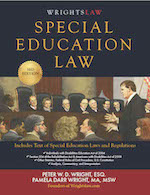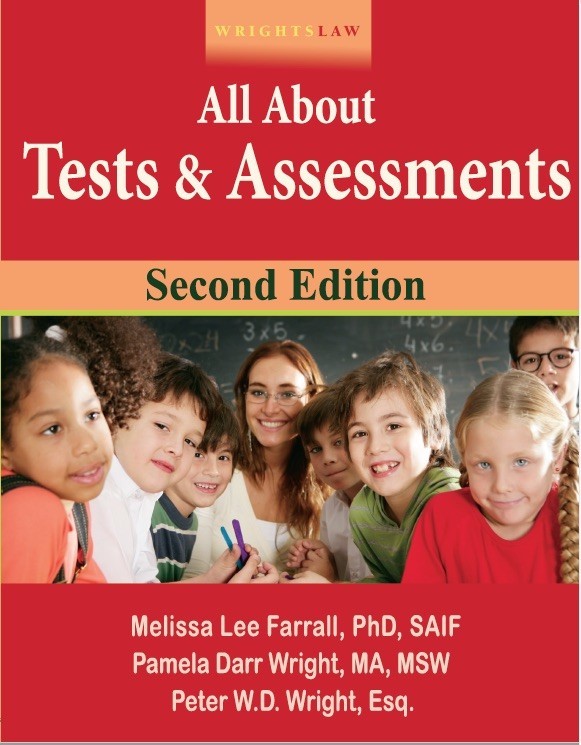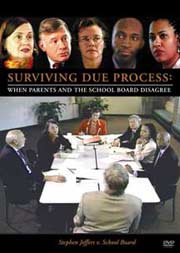|
Home
|
1. "Help!! I Need Good IEP Goals & Objectives"
DIANE writes:
I know that my son's IEP is wholly inadequate. The school’s IEP goal for him is "Commitment to academic success." If "Commitment to academic success" is not an appropriate goal, what should I propose in its place?
I need to find some good IEPs to help me construct a model. How are annual measurable goals and short term benchmarks defined?
Can you point me to a source or site that has a model of a well-written IEP?
MARY writes:
I need to get my hands on some good I.E.P. goals and objectives. I haven't had enough experience with this and need to feel more secure in this area. I am a special education graduate student in New York and will graduate in May.
Can you point me in the right direction?
2. The IEP Problem
You both ask for help in writing IEP goals and objectives. Diane is a parent, Mary is about to graduate from a special education program. You represent dozens of people who write to us every week asking questions about IEPs.
Why are IEPs so difficult? What makes this IEP process so confusing?
When you ask how to write IEP goals and objectives, you put the cart before the horse!
Before you can write ANY IEP goals or objectives, you must first identify the child’s unique needs -- clearly and specifically.
You know that the child’s IEP must include "present levels of performance" which should spell out ALL of the child’s unique educational needs that result from the disability.
The IEP must also include a plan to meet ALL of the child’s unique needs. The IEP should tell you exactly what the school will do to address the child’s needs. Finally, the IEP should give you a way to know if the IEP (educational plan) is working.
Annual goals must be objective and measurable. Why?
IEP goals and objectives are measurable to ensure that the child is making adequate progress.
Measurable goals and objectives also provide a way to evaluate whether the special education services being provided by the school are working (accountability!).
Assume that your child has a language learning disability like dyslexia. The child’s skills in reading, writing, spelling and math should be measured before the child enters special education and at frequent intervals thereafter.
IEP goals tell you what the child should accomplish in one year IF the services being provided are effective.
The following statement (citation follows) summarizes the IEP process:
"The heart of better IEP development
is a sequential, three-fold inquiry made by the IEP team:
"(1) What are this child’s unique educational characteristics / needs that must be taken into account in a truly individualized education program?""(2) What will the district do / provide in response to each of these characteristics?"
"(3) If the services are effective, what goals and objectives will the child reach? In other words, what accomplishments will indicate that the services are on the right track?"
(From "Better IEPs: How to Develop Legally Correct & Educationally
Useful Programs" by Barbara Bateman and Mary Jane Linden, page
91)
When you begin this process by analyzing the child’s present levels of functioning (on objective tests), the IEP process is less confusing. If you begin by trying to find "good goals and objectives," you’ll probably fail because the goals and objectives won’t relate to your child.
Pete says the IEP that Florence County prepared for Shannon Carter is one of the better written IEPs he has seen. Why? Florence County's IEP included two clear, measurable goals:
* Shannon will progress from the 5.4 to the 5.8 grade level in reading as measured by the Woodcock Johnson Reading Mastery Test *
* Shannon will progress from the 6.4 to the 6.8 grade level in math as measured by the Key Math Test *
The problem with this IEP? These goals were set far too low. Shannon was about to enter 10th grade. If she met these goals, she would fall even further behind.
3. The IEP Game Plan
Here is your game plan. First, download files from the Wrightslaw Libraries (list follows). Next, get a copy of the recommended book at your local library or bookstore.
IEP INFO FROM WRIGHTSLAW
Download and print the following articles from Wrightslaw. Plan on reading these articles more than once.
UNDERSTANDING TESTS & MEASUREMENTS
Get your personal copy of "Understanding Tests and Measurements"
Assume that your child has reading problems. To remedy these reading problems, your child has received special education services -- for three years. Has your child caught up with the peer group? Has your child fallen further behind?
What do standard scores, percentile ranks, subtest scores, and age and grade equivalents mean?
This article is required reading for ALL of our parents. To successfully negotiate for services that provide REAL educational benefit, you must learn how to interpret educational and psychological test scores.
NOTE FROM WRIGHTSLAW: When you download this article, make sure you get the graphics. It may be better to print article from the screen (rather than download it) to ensure that you have the graphics.
"Understanding Tests and Measurements" was the lead article on the LD Online site last week!
YOUR CHILD’S IEP: PRACTICAL AND LEGAL GUIDANCE FOR PARENTS AND ADVOCATES
The companion article to "Understanding Tests and Measurements"
IEP Goals & Objectives: A Tactics & Strategy Session With Pete Wright
APPENDIX A
Appendix A includes 40 Questions and Answers about IEPS. You need to get a copy of Appendix A to the federal regulations. Appendix A discusses requirements for IEPs, IEP meetings and teams, the parental role, transition, and other important issues.
Appendix A is in Wrightslaw: Special Education Law.
You can download a FREE copy of Appendix A from Wrightslaw
OTHER RESOURCES
Get a copy of "BETTER IEPS: HOW TO DEVELOP LEGALLY CORRECT AND EDUCATIONALLY USEFUL PROGRAMS" by Barbara Bateman and Mary Jane Linden
BETTER IEPs contains clear, simple instructions about how to develop IEPs, including IEP goals and objectives.
BETTER IEPs is divided into the following areas:
Chapter One: The IEP in Perspective
Chapter Two: The Legally Correct IEP
Chapter Three: Empty, Not Serious, and Other Wrong-Headed IEPs
Chapter Four: Educationally Useful IEPs: Doing It a Better Way
Chapter Five: IEP Myths, Battles, and Truths
BETTER IEPs includes Appendices about the IDEA Statute (1997), IDEA Regulations (Proposed), Model Notice to Parents of Procedural Safeguards, and References
You can get BETTER IEPs at your local bookstore or you can order it through The Advocate’s Bookstore. To order through The Bookstore, go to the Legal Section of the Bookstore at
https://www.wrightslaw.com/bkstore/bks_law.htm
While you’re waiting to get your copy of BETTER IEPS, go to LD Online and download "Writing IEPs for Success" by Dr. Bateman
4. Advocacy Tip: How To Use A "Parent IEP Attachment
A few months ago, Judy (an advocate from New Mexico) sent a great advocacy tip. We wanted to pass it on. Judy wrote:
I continue to be one big fan of your site. As a volunteer advocate, your site is the first one I refer parents to. I was delighted to see permission granted to reprint your articles so I may pass them on to parents who do not have access to the internet.
I'd like to tell you about a recent development. I have had great difficulty getting districts to take parent attachments seriously. Recently, I was told that the district could not attach such a document to the IEP.
I turned to PRIOR NOTICE in the Procedural Safeguards section of the statute.
PRIOR NOTICE specifies that suggestions put on the table must be accepted or rejected, and the IEP team must list the reasons for accepting or rejecting the proposal. I saw this done one time by a district in another community and it was very successful.
I devised a very simple form: a column for Proposal, a column for Accepted/ Rejected, a column for "Reason Accepted or Rejected."
If the request is "Accepted," a notation may be added about "Start Date" and "Who is Responsible" for initiating the proposal.
The parent sees to it that the IEP team formulates the reason for accepting or rejecting each proposal.
After doing this in a couple of meetings, the district actually suggested using my form to keep track of proposals and their disposition. I was so proud of them! They are in compliance.
And parents have definitive yes or no answers, and reasons are given for these decisions.
Using this form (even an unofficial form designed by a parent) has eliminated worries about inactivity and worries that someone will drop the ball, sidestep a request, or forget. The IEP team members know what issues have been resolved and what issues have not been decided. Issues that must be tabled for further investigation have a name attached and a date for an answer.
I don't think parents realize what a powerful tool this can be for them.
If parents can use this system to make the IEP process work for their child, the IEP process may become a little more "parent friendly." Again, thanks for being such a powerful resource for parents and professionals alike.
For a copy of Judy’s "Tip" and the "IEP Attachment" in html, go to:
5. Letter to Wrightslaw: Does Roger Know Too Much?
Roger wrote:
Some years ago I bought your Advocacy Pak. I used this information and your article about how to write a "Letter to the Stranger " to advocate for my child. After this, the school board attorney began to attend my child's IEP meetings.
I filed for due process. At the hearing, the school’s defense was that because I wrote a letter and advocated for my child, this justified their sending their lawyer to my child’s IEP meetings -- I advocated too much.
Can you believe this?
Roger
Can you believe this?
Read Pete’s answer -- and Roger’s reply
6. News Break: 11th Circuit Issues New Decision on Behalf of Autistic Child
On February 16, the Eleventh Circuit issued a favorable decision on behalf of an autistic child from Georgia in WALKER COUNTY SCHOOL DIST. V JENSINE BENNETT.
At the due process level, an Administrative Law Judge ordered the school district to reimburse the parents for the cost of Jensine's private schooling.
The school district was "aggrieved," and brought an action in U. S. District Court, seeking a reversal of the ALJ’s decision.
As part of their appeal, the school district requested that the court "hear a substantial volume of testimonial and documentary evidence in addition to the record of the administrative proceedings developed in the state system."
How much testimony and documentary evidence was a "substantial volume?"
". . . nineteen witnesses (whose testimony was variously offered through the means of personal appearance, depositions or affidavits), plus three categories of tangible or documentary evidence."
"The court found that five of the witnesses had already testified . . . the proposed testimony of several of the remaining witnesses was already in the record . . . In two instances the court found the proffered testimony to be irrelevant."
The Eleventh Circuit ruled on two issues:
"First is the question whether the district court erred in refusing to receive and consider the evidence the School District wished to offer in addition to the record of the administrative proceedings. The second issue is whether the district court erred in its judgment on the merits affirming the decision of the Administrative Law Judge."
The Court described judicial review
under IDEA as " . . . "puzzling" (id. at 898) and "somewhat confusing"
. . . because it differs from the norm in a way that produces three
distinct issues:
(1) How much deference, if any, should be given to the administrative decision if additional evidence may be taken and the standard to be applied is the preponderance of the evidence?(2) What standard should be applied in deciding what "additional" evidence, if any, should be admitted in the district court proceeding?
And (3) What is the appropriate procedural mechanism to be implemented in the district court in bringing the case before the court for a final decision?
Read the Eleventh Circuit’s decision in Walker
County School Dist. V Jensine Bennett
| |||||
|
|
|||||
|
Copyright © 1998-2025, Peter W. D. Wright and Pamela Darr Wright. All rights reserved. Contact Us | Press l Mission l Our Awards l Privacy Policy l Disclaimer l Site Map |
|||||




